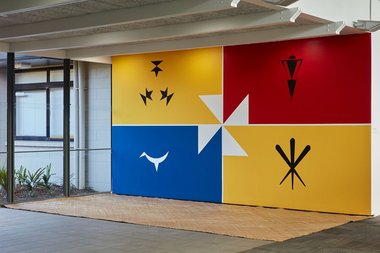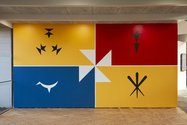John Hurrell – 10 September, 2018
Moving clockwise, the royal crown is replaced by a sacred figure wearing a decorative hair comb, the three swords that indicate three royal dynasties are replaced by three clubs (pōvai), Noah's dove (as a Biblical symbol of hope) is replaced a more abstract bowl-like version, and the three stars representing the three islands of Vava'u, Ha'apai and Tongatapu are replaced by designs (kupesi) taken from pōvai.
Pakuranga
Benjamin Work
Write it on the land, Seal it on the heart
12 August - 21 October 2018
Benjamin Work is mainly known for his public projects, murals painted on street fronts in an angular style coincidentally reminiscent of eighties artist John Lethbridge. Work tends to favour provocative eye-popping ‘Tongan’ colours like red and black, but his current exhibition on the Project Wall inside Te Tuhi is very different.
With a woven mat on the floor in front of it to encourage seated contemplation, his wall painting is based on the red, yellow and blue escutcheon part (not the crest) of the sila ‘o Tonga, the Tongan coat of arms (or Royal Standard, the monarch’s personal flag) that was designed in 1875. Work has replaced its ‘European’ heraldic motifs with his own Pasifika sensibility; indigenous symbols substituted for imperial ones. (Note that this is not about the red and white Tongan national flag.)
Four sets of emblems are involved within a wall that through colour is divided into quarters. Moving clockwise, the royal crown is replaced by a sacred figure wearing a decorative hair comb, the three swords that indicate three royal dynasties are replaced by three clubs (pōvai), Noah’s dove (as a Biblical symbol of hope) is replaced a more abstract bowl-like version, and the three stars representing the three islands of Vava’u, Ha’apai and Tongatapu are replaced by designs (kupesi) taken from pōvai.
In the centre where the four quarters converge, is a fifth motif; four triangles turning in an anti-clockwise direction like a child’s windmill, those triangles apparently representing the wings of two birds flying together, two replacement symbols for Christianity and a white star.
Overall it is a striking wall design Work has come up with. Quite dynamic and miles more interesting than the original from 1875—through the way it locks into the Te Tuhi architecture. A contemporary flag linked to the past.
John Hurrell


 Two Rooms presents a program of residencies and projects
Two Rooms presents a program of residencies and projects Advertising in this column
Advertising in this column



This Discussion has 0 comments.
Comment
Participate
Register to Participate.
Sign in
Sign in to an existing account.